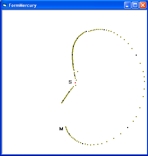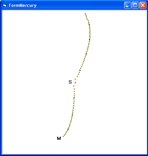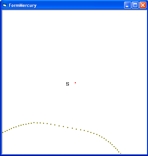- One of the posiblities is, that the path of the movement of the aphelion of the planet Mercury follows, what is called a horseshoe orbit. See "Figure 2"
Wikipedia & Planetoide 3753 Cruithne and
Paul Wiegert & Planetoide 3753 Cruithne
In order to understand this let us start at position 347 in "Figure 1"
- The direction of the Sun is straight up. The initial position of Mercury at aphelion is drawn as position 1 in "Figure 2"
- Starting from position 1 the angle at aphelion will slowly increase. First position 2 and next position 3, where the long axis almost will be horizontal.
- The question is will this movement continue.
- In order to answer that question study "figure 3" below:
^ ^ / \ | | / \ |^ |<---3 ---> || |. ^ / | / . 2 | / | / . | 1\ 1 3\ \ \ pos 1 pos 2 pos 3 figure 3"Figure 3" consists of 3 positions of both your hands.- pos 1 is equivalent of "figure 1" position 347.
The left upper arrow is your left hand and this represents the movement of the Sun.
The right upper arrow is your right hand and this reperents the long axis of planet Mercury. Number 1 (hand joint) is the aphelion. - Turn your right hand counter clock wise. (See pos 2). This represents the movement of the long axis. The aphelion will go through the points 1, 2 and 3. This are the same points 1,2 and 3 as in "Figure 2"
- Move both hands 90 degrees clock wise. (See pos 3) and compare this with "figure 1" position 257. The two are the same. The hand at the top points towards the right and represent the movement of the Sun. The hand at the bottom shows the direction of the long axis.
- pos 1 is equivalent of "figure 1" position 347.
- If you observe the behavior of position 257 you will see that the distance will start to decrease and the aphelion will reach position 4 in "Figure 2".
-
To observe what happens next you have to select the following simulation: 7 planets simulation . This is a simulation over a period of 275000 years
- From position 4 the aphelion will start to move backward to position 5 and 6. Position 6 is equivalent to position 77 in "figure 1". After position 6 the distance will start to increase to position 7. Position 7 is equivalent to position 167 in "figure 1". The angle at aphelion will increase again until the initial position 1 is reached.
- The total revolution time of one aphelion movement is roughly 160000 years. The nearest point is after roughly 84000 years. The closest distance is than 4000000 km which is much more than the radius of the sun as approximate 700000 km.


In short the answer on question 3 is one, assuming that the horseshoe orbit of the aphelion moves synchronuous with the movement of the Sun. This is only a prediction.
- If you start from position 77 the path is also a horseshoe orbit.
5 m m 6 4 m m m m m m m m S m m S = Sun <------ 7 3 m m 8 m x m x m 1a 2 m m 1b m m Figure 4

The following table shows the angle, distance and year at the different positions. point angle distance year 1a 257 58000000 2000 1b 270 73000000 8000 2 325 90000000 15500 3 360 91000000 18000 4 405 85000000 22000 5 450 56000000 36000 6 457,4 23000000 51000 7 360 4000000 56000 8 457,4 8900000 58000 - If you start from position 257 the path is also a horseshoe orbit.
x x x 4 m m 3 m m S S = Sun 2 ------> m m m m 1 Figure 5

The following table shows the angle, distance and year at the different positions. point angle distance year 1 257 58000000 2000 2 180 7000000 17800 3 90 4000000 18000 4 74 50000000 30000 - If you start from position 167 current expectation is that the path is also a horseshoe orbit.
| | |S S = Sun | V 3 1 m 4 2 m m 5 10 6 7 m 9 m 8 Figure 6
The following table shows the angle, distance and year at the different positions. point angle distance year 1 257 58000000 2000 2 270 61000000 13000 3 333 86500000 34400 4 332 91000000 36200 5 321 11000000 42200 6 300 113000000 46600 7 297 122000000 50000 8 270 128000000 52800 9 245 132000000 58000 10 204 124000000 65600 In short the answer there are three possible answers on question 3:
- one, assuming that the horseshoe orbit of the aphelion moves synchronuous with the movement of the Sun.
- many, assuming that the path is an ellipse.
- unknown, assuming that Mercury will collide with the Sun. This can happen when the initial position is between 77 and 167 for example at 127 degrees or when the initial position is between 167 and 257 for example at 207 degrees.
- The direction of the Sun is straight up. The initial position of Mercury at aphelion is drawn as position 1 in "Figure 2"



